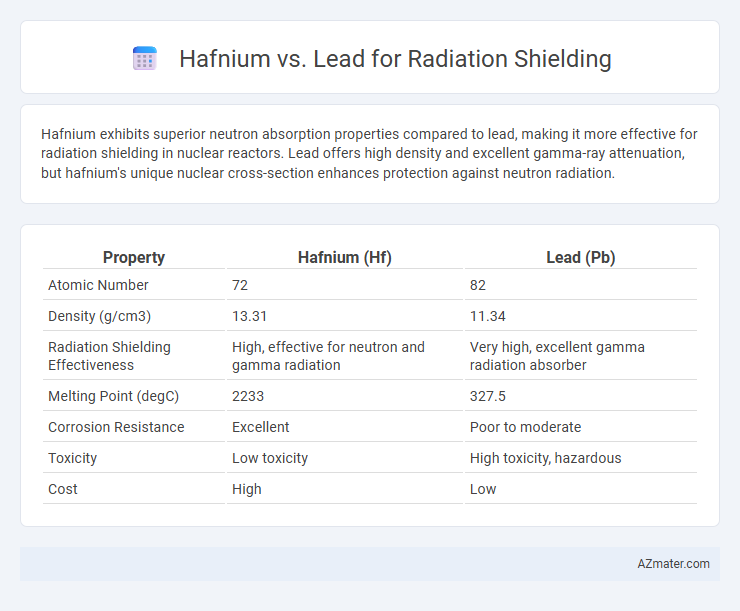Hafnium exhibits superior neutron absorption properties compared to lead, making it more effective for radiation shielding in nuclear reactors. Lead offers high density and excellent gamma-ray attenuation, but hafnium's unique nuclear cross-section enhances protection against neutron radiation.
Table of Comparison
| Property | Hafnium (Hf) | Lead (Pb) |
|---|---|---|
| Atomic Number | 72 | 82 |
| Density (g/cm3) | 13.31 | 11.34 |
| Radiation Shielding Effectiveness | High, effective for neutron and gamma radiation | Very high, excellent gamma radiation absorber |
| Melting Point (degC) | 2233 | 327.5 |
| Corrosion Resistance | Excellent | Poor to moderate |
| Toxicity | Low toxicity | High toxicity, hazardous |
| Cost | High | Low |
Introduction to Radiation Shielding Materials
Hafnium and lead are both employed in radiation shielding due to their high density and atomic numbers, which enhance their ability to attenuate ionizing radiation such as gamma rays and X-rays. Lead, with an atomic number of 82 and a density of 11.34 g/cm3, is traditionally used for shielding because of its affordability and effectiveness in blocking gamma radiation. Hafnium, possessing an atomic number of 72 and a slightly higher density of 13.31 g/cm3, offers superior neutron absorption capabilities and improved mechanical properties, making it advantageous in specialized nuclear applications requiring efficient radiation protection.
Overview of Hafnium: Properties and Applications
Hafnium is a dense transition metal with a high atomic number (Z=72) and excellent neutron absorption capabilities, making it effective for radiation shielding, especially in nuclear reactors and neutron control applications. Its corrosion resistance, high melting point of 2233degC, and mechanical strength allow it to perform under extreme conditions where lead and other materials may degrade. Hafnium alloys and compounds are increasingly utilized in control rods and protective coatings, highlighting its versatility beyond conventional lead-based shielding.
Lead as a Traditional Radiation Shield
Lead has long been the standard material for radiation shielding due to its high density of 11.34 g/cm3, effectively attenuating gamma rays and X-rays in medical, industrial, and nuclear applications. Its relatively low cost and ease of fabrication make it a preferred choice for protective barriers, yet concerns about toxicity and environmental impact prompt the search for alternatives. While hafnium, with a higher density of about 13.31 g/cm3 and better mechanical properties, offers improved radiation attenuation, lead remains widely used because of its proven performance and established handling protocols.
Atomic Structure and Density: Hafnium vs Lead
Hafnium offers superior radiation shielding compared to lead due to its higher atomic number (72) and greater density (13.31 g/cm3) versus lead's atomic number (82) but slightly lower density (11.34 g/cm3). The densely packed electron cloud of hafnium's atomic structure enhances its attenuation of gamma rays and X-rays more effectively than lead. Consequently, hafnium's combination of atomic number and density provides more efficient absorption of ionizing radiation, making it a preferable material for compact shielding applications.
Effectiveness in Attenuating Radiation
Hafnium demonstrates superior effectiveness in attenuating radiation compared to lead due to its higher atomic number (Z=72) and density, which enhance its ability to absorb gamma rays and X-rays. Its dense electron cloud increases the probability of photoelectric absorption and Compton scattering, providing more efficient shielding in nuclear reactors and radiological environments. Lead remains widely used for gamma and beta radiation shielding, but hafnium's performance is particularly advantageous in compact, high-radiation settings where maximum attenuation is critical.
Health and Environmental Considerations
Hafnium offers superior radiation shielding properties compared to lead due to its higher density and atomic number, which enhances protection against gamma rays and neutron radiation. Health concerns with lead stem from its toxicity and potential for bioaccumulation, causing neurological and organ damage upon exposure, whereas hafnium is considered less toxic, reducing occupational health risks. Environmentally, lead poses significant contamination hazards during mining, use, and disposal, while hafnium's environmental footprint is lower, making it a safer alternative for long-term radiation shielding applications.
Weight and Space Efficiency Comparison
Hafnium offers superior radiation shielding properties compared to lead, with a higher density of approximately 13.31 g/cm3 versus lead's 11.34 g/cm3, enabling thinner and lighter shielding designs. Its higher atomic number (72) enhances the attenuation of gamma rays and neutrons, reducing the required thickness and space for effective protection. Consequently, hafnium provides greater weight and space efficiency in radiation shielding applications, especially critical in aerospace and medical devices where minimizing mass and volume is essential.
Cost Analysis of Hafnium and Lead
Lead remains the most cost-effective material for radiation shielding due to its widespread availability and low price per unit weight, typically costing around $2 to $3 per pound. Hafnium, although offering superior neutron absorption and higher density, commands a significantly higher cost--often exceeding $200 per pound--making it economically impractical for large-scale shielding applications. When balancing performance with budget constraints, lead is favored for conventional uses, while hafnium is reserved for specialized scenarios where enhanced radiation resistance justifies the investment.
Practical Applications in Industry and Medicine
Hafnium offers superior neutron absorption properties compared to lead, making it highly effective for radiation shielding in nuclear reactors and medical radiation therapy equipment. Lead remains widely used due to its cost-efficiency and excellent gamma radiation attenuation, especially in protective barriers and shielding garments within hospitals and industrial radiography. Industries increasingly favor hafnium for compact, high-performance shielding solutions in environments with mixed radiation fields, while lead continues to dominate large-scale shielding projects due to its availability and ease of fabrication.
Future Trends in Radiation Shielding Materials
Hafnium exhibits superior neutron absorption and high melting point, making it an emerging candidate for advanced radiation shielding in nuclear reactors and space applications. Lead remains widely used due to its cost-effectiveness and dense atomic structure, but concerns over toxicity and weight drive research toward lighter, safer alternatives like hafnium alloys and composite materials. Future trends focus on developing hybrid shields combining hafnium's neutron attenuation with innovative polymers and nanomaterials to enhance protection while reducing environmental impact and structural weight.

Infographic: Hafnium vs Lead for Radiation Shielding
 azmater.com
azmater.com